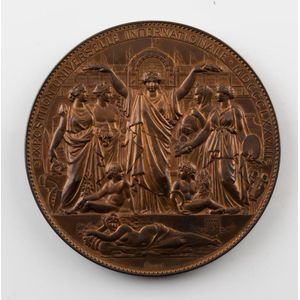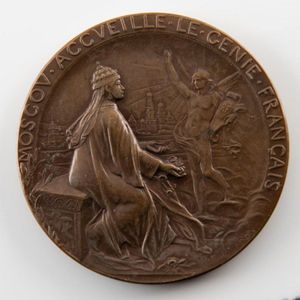France-Russia Alliance Medal 1893
You must be a subscriber, and be logged in to view price and dealer details.
Subscribe Now to view actual auction price for this item
When you subscribe, you have the option of setting the currency in which to display prices to $Au, $US, $NZ or Stg.
- Obverse - Obverse means the front face of a coin or medal, and the reverse means the back face. The obverse of a coin is commonly called heads, because it often depicts the head of a monarch or famous person.
- Bronze - An alloy of copper and tin, traditionally in the proportions of about 9 parts of copper to 1 part of tin.
The discovery of bronze in Western Asia in the 4th century enabled people to create metal objects which were superior to those previoulsy possible because of its strength and hardness, and it has been used throughout the world for weapons, coins, tools, statuary and other decorative items.
It is very fluid in a molten state, and its hardness, strength when set, and non-corrosive properties makes it most suitable for casting sculpture.
This item has been included into following indexes:
Visually similar items

1910 Buenos Aires Centennial International Exposition: Group of (4) medals comprising two by Rossi, the French Pavillion plaque by Roques, and another by Rossi & Mackay. Lovely group; hard to assemble.

Gilded Bronze medals (2) by Louis Bottee (63 mm, 98g & 104g.) the first awarded to 'Boehler Freres', the second to 'Victoria Gooch & Cie.'.

Four medals Fiore Internationale De Marseille, 1924, a bronze medal by J. Vezian, in original tan leatherette case (6.9 cm) Exposition Internationale Le Trocadero, Paris, 1937, a bronze medal by R.Benard. (5 cm) Exposition Interale Paris, a bronze medal by

France: 1891 Exposition Francaise a Moscou - bronze medal (64 mm, 105g.) by Louis-Oscar Roty. The obverse depicts a seated female figure representing Moscow welcoming La France. The reverse shows two shields, the one on the left with the Russian coat-of-ar
